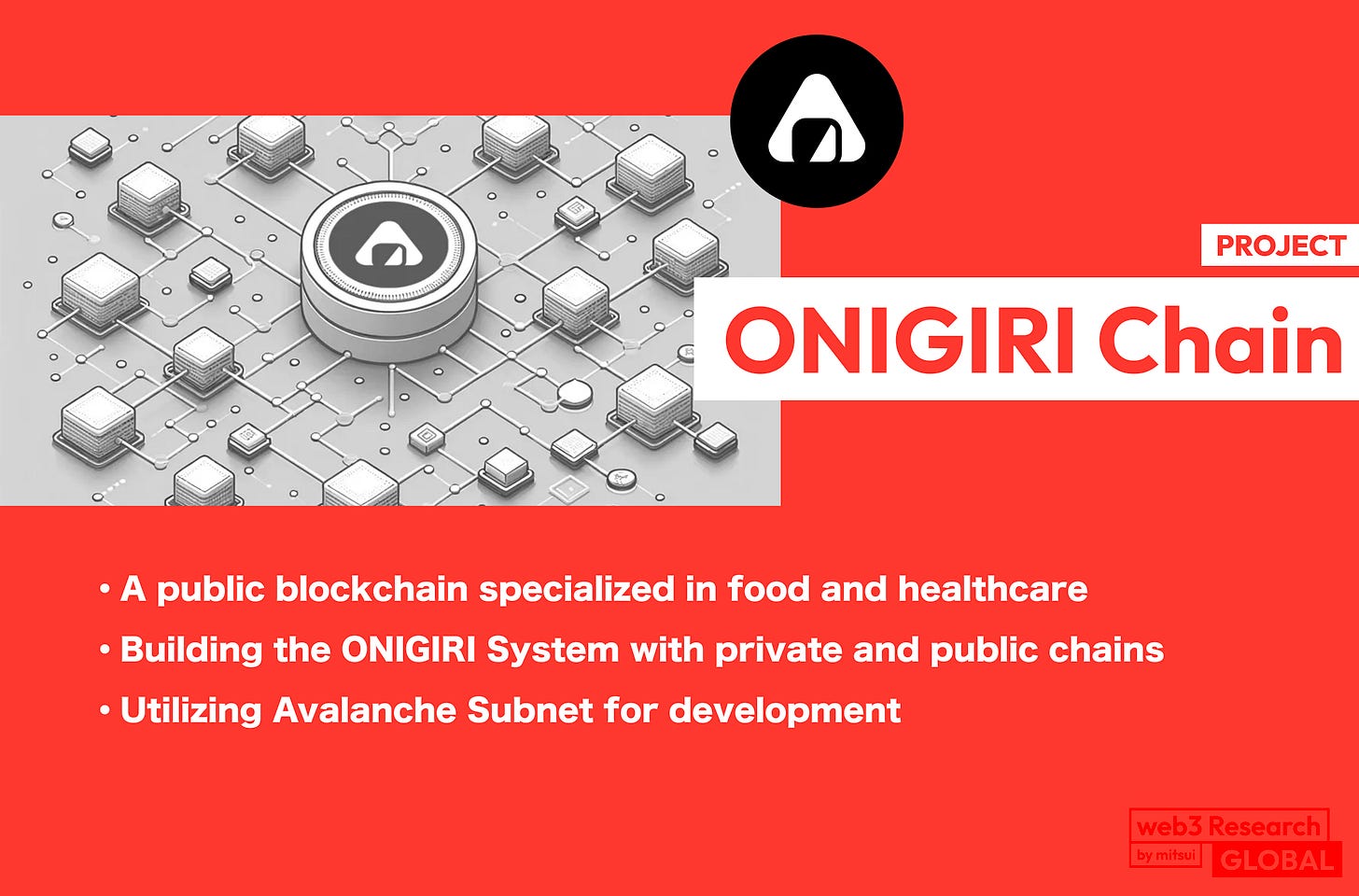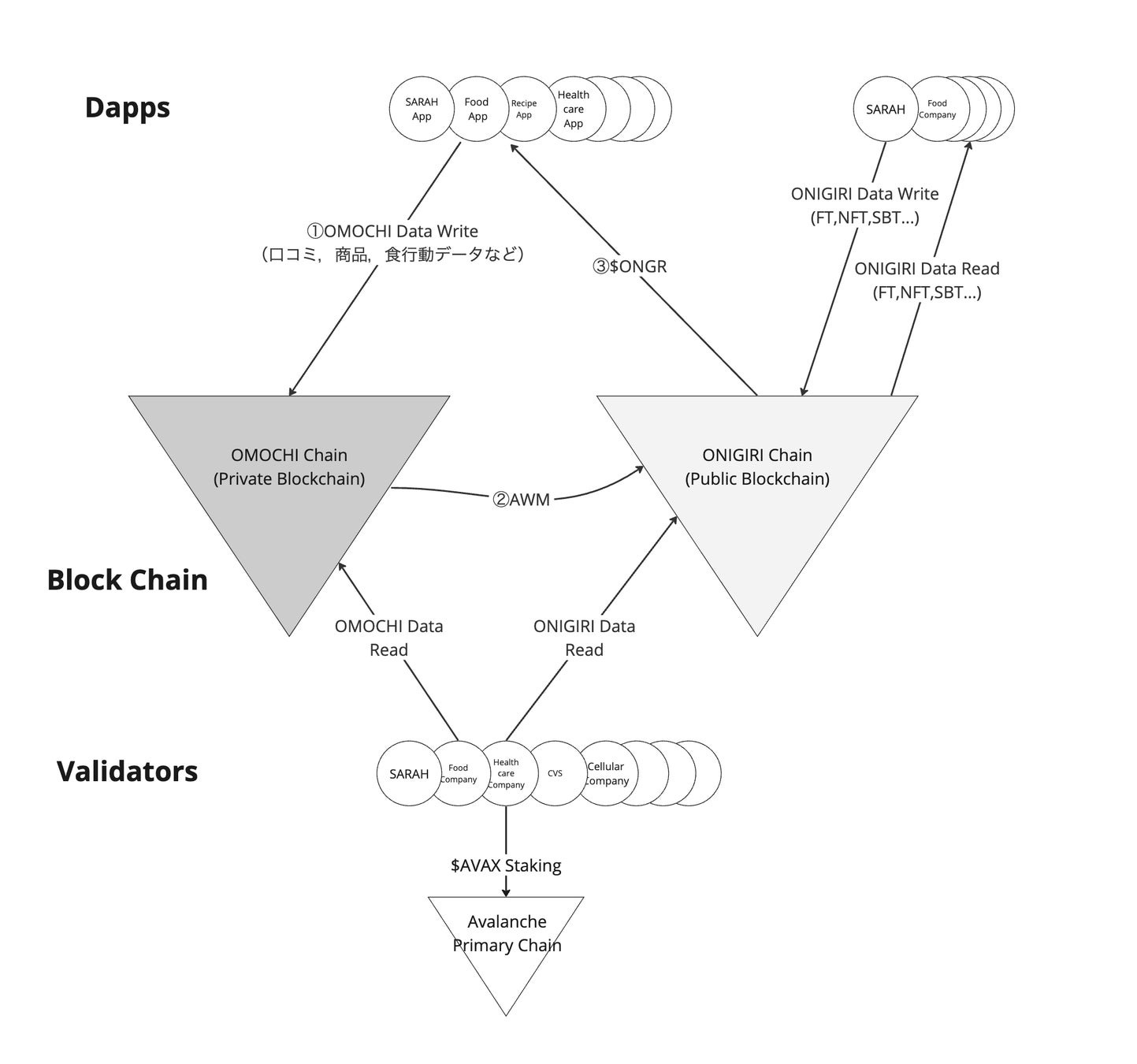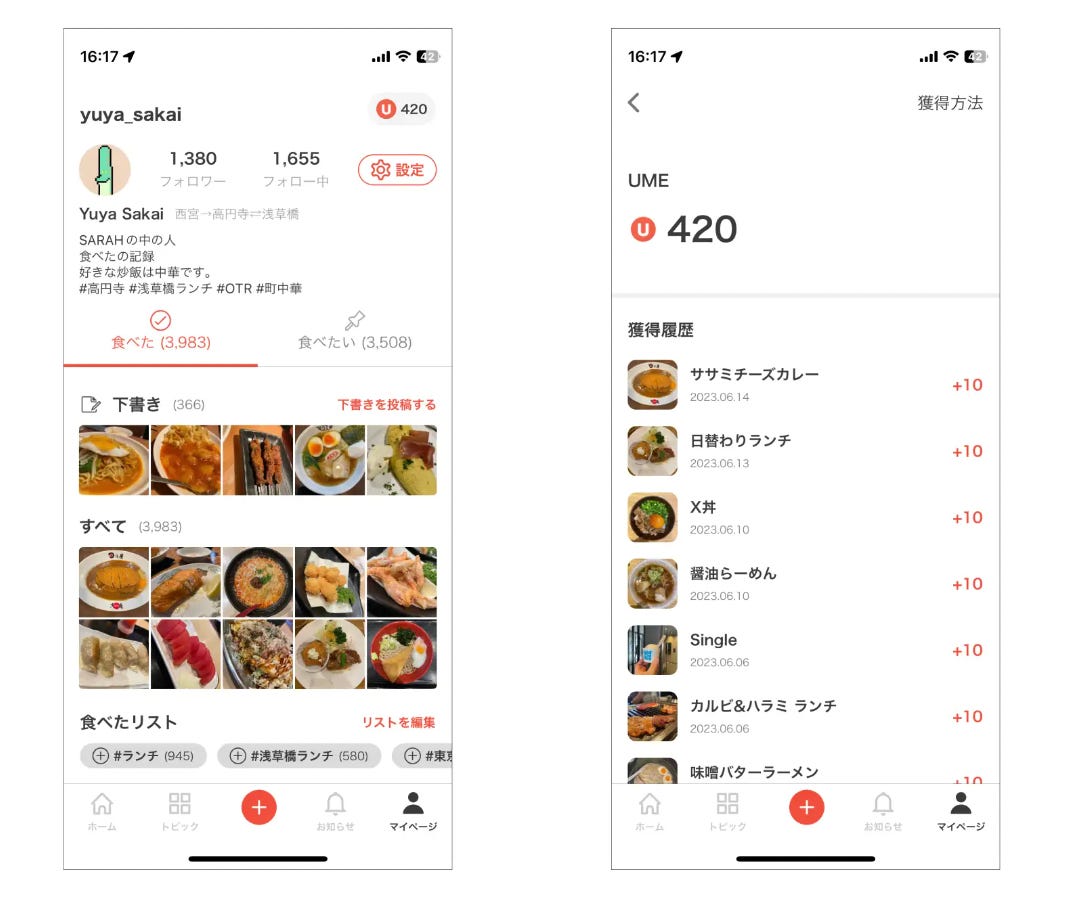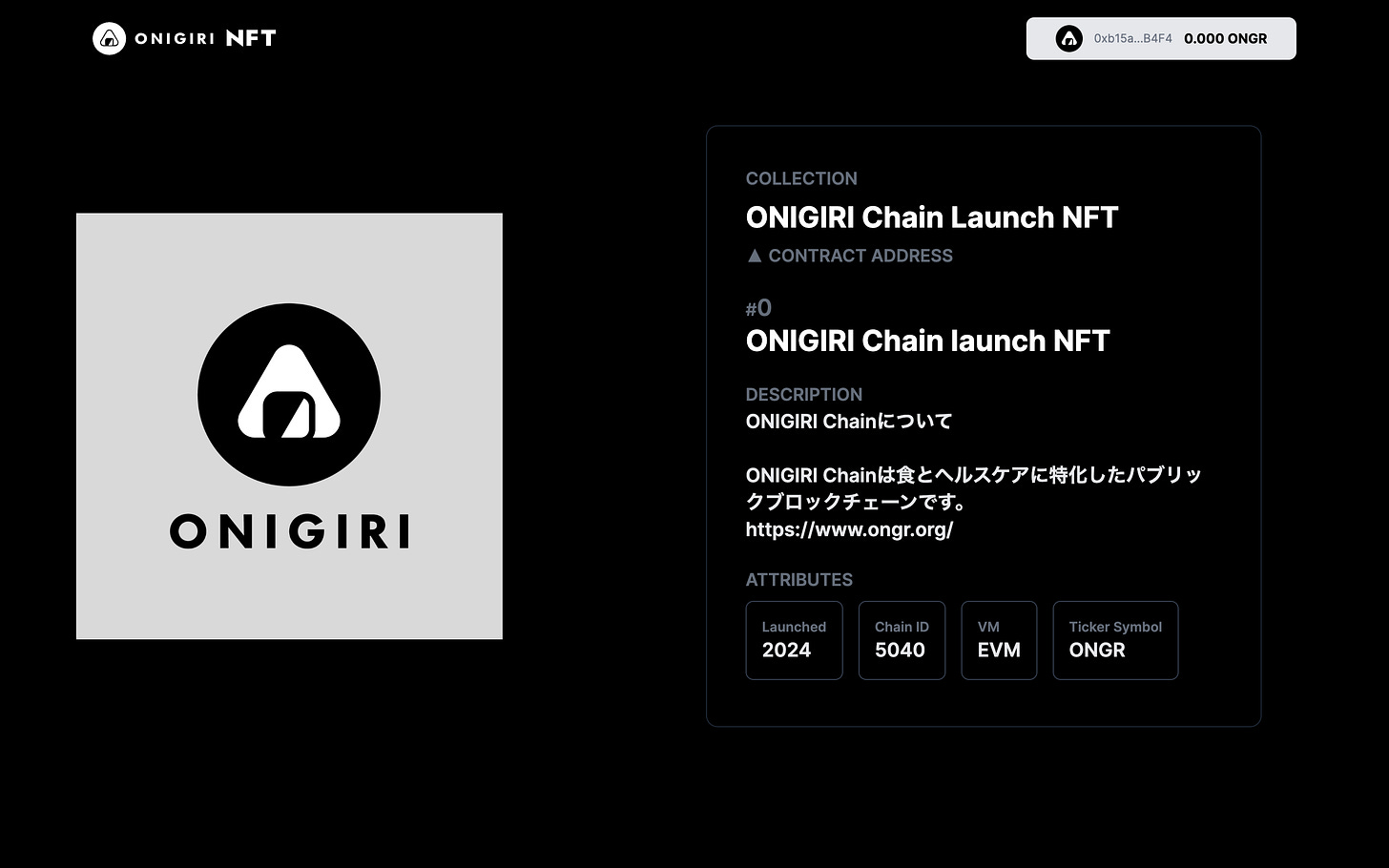【ONIGIRI Chain】 A public blockchain specialized in food and healthcare / Building the ONIGIRI System with private and public chains / Utilizing Avalanche Subnet for development
Gourmet app "SARAH" and other developed by SARAH Co., Ltd. This is a proprietary blockchain developed using the Avalanche Subnet.
Good morning.
I am Mitsui, a web3 researcher.
Today, I researched about "ONIGIRI Chain".
Table of Contents
1. Overview | What is ONIGIRI Chain?
-Mechanism
-Features
2. Transition and Outlook | Aiming for a Common Data Infrastructure for Food and Healthcare
3. Discussion | Speculating on Next-Generation Consortium Chain Use Cases
Overview | What is ONIGIRI Chain?
"ONIGIRI Chain" is a public blockchain specialized in food and healthcare. It is a unique blockchain developed by SARAH Co., Ltd., which develops gourmet app "SARAH," utilizing Avalanche Subnet.
◼️Mechanism
There are two chains: the private blockchain "OMOCHI Chain" and the public blockchain "ONIGIRI Chain," which together are referred to as the "ONIGIRI System."
Here is an overview of the system, but to briefly explain its mechanism:
Data written on the OMOCHI Chain is communicated to the ONIGIRI Chain through "Avalanche Warp Messaging" without the content being publicly disclosed, and $ONGR is distributed as a reward on the ONIGIRI Chain.
OMOCHI Chain is a private chain, allowing only validators to view and use the data.
ONIGIRI Chain is a public chain, allowing anyone to write, view, and use the data.
It is possible to differentiate between public data that anyone can view/use and private data that can only be viewed/used by specific businesses.
The feature is the existence of the private chain "OMOCHI Chain".
While transparency in blockchain is a crucial concept, it significantly compromises the user experience when all user data is publicly available in actual use cases. You wouldn't want your entire food log on Tabelog to be public, right?
On the other hand, the current practice of storing such data on Web 2 servers ensures information confidentiality, but it also leads to data loss upon service termination and siloed histories without interoperability between services.
To address these issues, we propose a two-chain structure consisting of the private chain "OMOCHI Chain" and the public chain "ONIGIRI Chain".
First, reviews and product data (user activity history) from Dapps will be recorded on the private chain "OMOCHI Chain". This ensures information confidentiality while enjoying the benefits of blockchain's immutability and interoperability.
Then, only the recorded information will be sent to the public chain "ONIGIRI Chain" in a trustless manner, and users will be rewarded with the native token "$ONGR" as an incentive.
This ONIGIRI System is made possible by utilizing the Avalanche Chain provided by Ava Labs, and it is said to be the world's first use case of its kind.
By the way, the movement of information between chains is facilitated by Avalanche Warp Messaging (AWM), which enables native cross-subnet communication. AWM allows VM developers to implement any communication protocol between any two subnets. (For more details, see here)
◼️Features
The ONIGIRI System has the following features:
Use without gas fees
Data anonymization
Calculation of data market value using $ONGR
Achieving interoperability
We aim to create a common foundation for storing food and healthcare-related information that has been previously siloed, making it easily accessible to many users.
Transition and Outlook | Aiming for a Common Data Infrastructure for Food and Healthcare
SARAH Co., Ltd., the developer behind the gourmet app "SARAH," is also a food startup that handles data services for food planning and development, such as "FoodDataBank."
In particular, "SARAH" allows users to post and search by menu, and it has become a platform with over 2 million users posting their reviews.
Such "SARAH" has been experimenting with token-based economics design, and in June 2023, released UME, an app token on the off-chain. By posting a review, UME will be rewarded based on the content of the post.
Afterwards, in September 2023, we formed a partnership, including strategic support from Ava Labs, marking the first partnership of its kind in Japan. This partnership has led to the development of the current chain.
In the future, it is aimed to utilize blockchain technology to store data on food and healthcare that are currently siloed, within a common standard. This will enable common rewards and mutual cooperation, and eventually be applied in a wide range of fields such as finance, insurance, and healthcare.
Furthermore, we are currently distributing NFTs as part of our launch commemoration. If you are interested, please try minting them! I also received some, and it worked without gas. It is mentioned that Dapps are preparing the infrastructure to issue such NFTs and SBTs.
Analysis | Next-Generation Consortium Chain?! Speculating on Use Cases
Finally, let's dive into some analysis.
I explained the mechanism in the overview, but let's speculate on some deeper use cases. Since there was no clear wording, there is a possibility of my interpretation being incorrect, so I'm categorizing this as "speculation without permission". Please refer to the official information on the HP or DOC.
Reiterating, in this mechanism, it is likely that data interoperability will only be achieved at the validator layer. Instead of the content of the data being transmitted through AVM to ONIGIRI Chain, only the fact of receiving it should be transmitted. Therefore, user data does not remain on ONIGIRI Chain.
I believe that the reason for designing this flow is to incentivize users through the distribution of $ONGR and to create a loyalty program-like concept on the ONIGIRI Chain. Dapps can also issue NFTs and SBTs as part of this process, and it is likely that the web2 app that integrates data with the OMOCHI Chain is also being considered.
Therefore, only the usage history of user data from web2 apps (just the fact that XX entries were made, not the actual content) and the distributed NFTs and SBTs are publicly available on the public chain.
Furthermore, validators can read data from the OMOCHI Chain, allowing them to understand the state of each user. If these validators continue to increase, they could become a common database-like entity that allows for the sharing of user data across different companies.
While this is speculation based on personal opinion and bias, if we delve deeper, I feel that this two-chain structure is a "next-generation consortium chain."
The definition of a consortium chain may vary from person to person, but if we consider it as a privately operated chain with limited validators, there are advantages such as no gas fees and easier control of information and protocol based on the logic of the company. On the other hand, it lacks transparency and interoperability, which can be criticized for not embodying the essence of blockchain.
I believe that when blockchain achieves mass adoption, it is unlikely that all data will be on the public chain. I do not want all the data from the services I currently use in my daily life to be publicly available. However, I think storing that data in a DID for interoperability of information, decentralization of ownership, and personalized experiences will accelerate.
I felt that the "ONIGIRI System" could be one use case that achieves all of these: data privacy, transparency, and interoperability.
In terms of prospects and usage, I predict that "ONIGIRI System" will not simply attract Dapps like a general-purpose chain, but will evolve by strengthening the platform of "SARAH" as an app-specific chain. Specifically, recording "SARAH" data on a private chain and contributing to the increase in posting incentives through token distribution based on that. Similarly, other apps related to food and healthcare will use it for increasing user incentives.
Additionally, restaurants will issue their own NFTs, SBTs, and even unique tokens for loyalty purposes.
On the front end, user incentives and loyalty usage will continue to circulate, while on the back end, data related to food and healthcare will accumulate like DIDs, and validators will be able to access this data. By including businesses that have a high affinity with "SARAH" as validators, the "SARAH" economy can be expanded.
I feel that this serves as a reference for building one's own app economy using blockchain technology, although it may not be articulated very clearly. Of course, this is just my own speculation, so I cannot predict what will happen in the future... I will continue to pay attention and follow the information!
That concludes the explanation of "ONIGIRI Chain"!
Disclaimer:I carefully examine and write the information that I research, but since it is personally operated and there are many parts with English sources, there may be some paraphrasing or incorrect information. Please understand. Also, there may be introductions of Dapps, NFTs, and tokens in the articles, but there is absolutely no solicitation purpose. Please purchase and use them at your own risk.
About us
A web3 newsletter delivered in five languages around the world. We deliver various articles about web3, including project explanations, news and trend analysis, and industry reports, every day. You can subscribe for $8 per month ($80 per year) and receive research articles that took 100 hours to complete every day.
Author
mitsui
A web3 researcher. Operating the newsletter "web3 Research" delivered in five languages around the world.
Contact
The author is a web3 researcher based in Japan. If you have a project that is interested in expanding to Japan, please contact the following:
Telegram:@mitsui0x
*Please note that this newsletter translates articles that are originally in Japanese. There may be translation mistakes such as mistranslations or paraphrasing, so please understand in advance.







